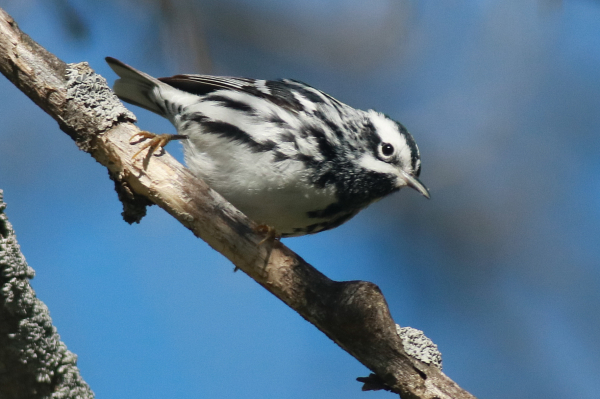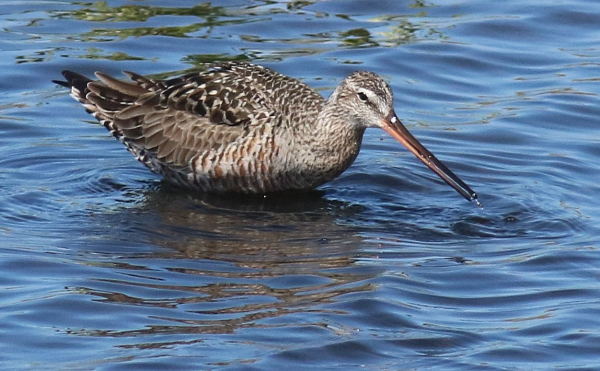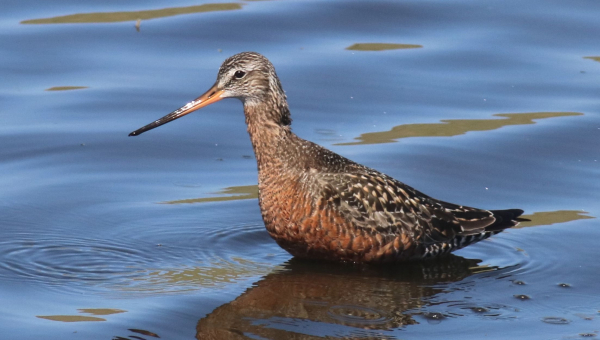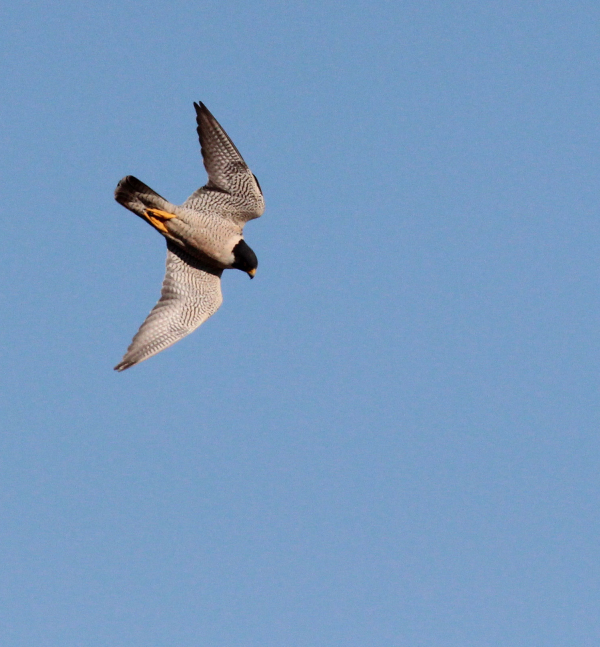
A break-through photo of a Black-and-White Warbler in action was an early highlight of the week.

A rare observation of a migrating Peregrine Falcon led to a spectacular diving chase after a pair of Blue-winged Teal.

A flock of extremely rare Hudsonian Godwits was feeding only 250 yards south of The Birding Wire office! Although Hudsonian Godwits migrate across the Great Plains each spring, they are rarely encountered during their short stopovers to feed and rest.

This male Hudsonian Godwit and the female pictured above it were photographed 3 years earlier about 8 miles to the south during a memorable close encounter.
|
I was jolted out of my office chair by the sight of a Black-and-White Warbler on the ash tree next to my feeding station, even while a small flock of colorful American Goldfinches and a spectacular male Baltimore Oriole were present. Yet it was the little pied warbler that brought me to my feet for even just a momentary view of the arboreal warbler. Such was my reaction to a rarely seen and much sought after bird that appeared right out my window Wednesday afternoon.
As I stood at the edge of my bay windows, watching the Black-and-White working from tree to tree, a Least Flycatcher landed not feet, but inches away from my knees. The moral of the story is that while a feeding station attracts a lot of remarkable birds, the “habitat” attracts birds looking for small insects. Then too, the insect eaters are probably attracted to that location by the action created by the other birds utilizing the feeders.
Soon thereafter, a big Harris’s Sparrow perched on a low twig on the ash tree long enough to sing a few times before dropping to the ground to scavenge seeds dropped from the feeders along with equally enjoyable White-crowned and White-throated Sparrows. Four hours later, a little Black-and-White Warbler and Least Flycatcher reappeared at my ash tree for a moment. Minutes after that, I was absorbed in writing, but looked up in between breaths to uncontrollably say “WoW” aloud. Perched before me at a feeding station perch was the dramatic bright-pink crescent of a male Rose-breasted Grosbeak! It didn’t stay five seconds; only long enough for me to want to absorb more of this newcomer, with a heavy hitting duo of a Baltimore Oriole and a Harris’s Sparrow perched there too.
All this on a very overcast day with a mid-afternoon downpour for about an hour. The warbler, flycatcher, and grosbeak were probably short-stopped by the rain. Twenty minutes later, the grosbeak flashed in to perch on my hopper feeder, without grabbing even one seed, then returning to the perch where I originally saw it – and it sang! Sorry for the play by play account, but for me, these were some exciting birding moments at my home office.
Migrant Traps
After all the migrant action at my feeding station Wednesday afternoon, I took an evening drive to check on two of my migrant traps, locations where migrating songbirds and flycatchers tend to funnel into for cover, rest, and feeding opportunities. The first migrant trap is just 200 yards southeast of my yard, which I refer to as Melody’s Grove, where I found another Black-and-White Warbler foraging on a tree trunk, a couple Orange-crowned Warblers, the first Ruby-crowned Kinglet of spring, a couple Hermit Thrushes, and a couple Least Flycatchers – all on the south end of the grove, across the road from little house where my grandparent’s lived.
Next, I drove to the best migrant trap so far this season, the Schoolhouse Grove. Although it was pretty quiet the first couple minutes, I did spy a sneaky Brown Thrasher and a couple Hermit Thrushes. A small wave of migrants appeared after about five minutes, and among a small flock of Yellow-rumped Warblers, I was excited to see a male Common Yellowthroat, a Yellow Warbler, an Orange-crowned Warbler, and the rarest among them and the first I’ve seen in a year, a Northern Waterthrush!
The next morning with the sun shining I hustled back to Schoolhouse Grove hoping my expectation of a fallout would hold true, in spite of the strong west wind. It didn’t look good initially, but when I pressed farther into the grove than usual, a sheltered opening was filled with a flurry of active warblers. I spent most of the morning there photographing, and returned to continue during the evening. The day was so productive that I share that story with a selection of photos in this issue’s Bird Photography article. What fun I had!
The following day – Friday – was epic, and I share that story and a few of the resulting photos in this issue’s Birding Lifestyles article. Overall, Thursday and Friday were such spectacular days of birding that together they must compare with some of my best days afield in Dakota!
Birding Notes
– At home Thursday, two or three male Baltimore Orioles attended my feeders, including my hummingbird nectar feeder, which is a first. Never before have I had an oriole feed at my feeder, even though I’ve had a dozen orioles at my feeding station at one time before. This week though, one or more have been sipping sugar-water occasionally.
– Also Thursday, I sighted the first Black Terns and Eastern Kingbird of the season.
– Native Sparrows vacated the area overnight Friday.
– Late Saturday the first Gray Catbird of spring visited by oriole feeder while 11 American Goldfinches, a Hairy Woodpecker and a Downy attended other feeders.
– Monday, three different female Baltimore Orioles arrived at my feeding station; all previous orioles were males. A lone Harris’s Sparrow and several Chipping Sparrows also were noted, and during late afternoon I was excited to see the first Ruby-throated Hummingbird of May. You would think that with this kind of new species input to my feeding station, that there would be an area-wide fallout of songbirds, but there were none.
– It’s interesting to note that the hummingbird flew up to the nectar feeder while a male Baltimore Oriole was feeding on it. The hummer hovered a moment, then zipped within a couple feet of me, flashing it’s ruby gorget as I stood on my front steps.
– As for warblers, most cleared out overnight Thursday, and I couldn’t find one Saturday, Sunday, or Monday. Nonetheless, the best is yet to come, and the greatest variety of warblers and other songbirds will be migrating in mixed species flocks during the coming week – can’t wait!
Shorebird Stopovers
There have been precious few shorebird sightings this spring, with most early migrants including Marbled Godwits, American Avocets, and Willets apparently continuing northward. Water levels are the highest ever recorded in this area, inundating traditional shallows, mudflats, and bare shorelines. However, there are plenty of wet meadows and short-term wetlands (ephemeral wetlands). I tend to use May 10th as a hallmark date of Arctic-nesting shorebird stopovers, so began to wonder if shorebirds were flying past this area due to the high water levels. But Friday, May 15th, I noticed a mix of Pectoral Sandpipers, Long-billed Dowitchers, and Least Sandpipers in a small shallow water basin in an agricultural field 50 yards east of Melody’s Grove. They were only present for the day, but it was encouraging.
Sunday provided a special treat, when just 250 yards south of home, 18 Hudsonian Godwits and about 30 Long-billed Dowitchers were frantically probing the rich black mud below a shallow basin in the middle of the agricultural field west of Melody’s Grove. The Hudsonian Godwits were especially exciting, for they are rarely seen during their spring migration across the Great Plains. Hudsonians provided memorable photo opportunities for me here 3 years ago, although, for the record, their appearance is a week later now than in 2017. By late afternoon, only 3 Hudsonian Godwits remained, and they were still present Monday morning, but they left before I checked back Monday afternoon, when about 15 dowitchers were present.
Migrating Peregrine
Speaking of Arctic-nesting migrants, earlier in the week, I saw an uncharacteristic raptor silhouette headed in my direction. Imagine my excitement when I quickly realized it was an adult Peregrine Falcon! I tried to get into position to photograph the stream-lined beauty that exuded power in flight, shadowing its movements north. It was too far off for more than a documentary photo, and the falcon began circling ever-higher as if to continue its migration.
But suddenly, a pair of Blue-winged Teal took flight from a marsh between the falcon and my position, and I was surprised to see the falcon immediately break into a steep dive – a supreme falcon stoop – that brought the Peregrine low just a few feet in front of my windshield moving at top speed as the teal fled in panic mode to the surface of a lake to my right – probably with the intent to dive into the water to escape the falcon, if necessary. The falcon ended the dive prematurely and zoomed northward again.
I pressed forward with renewed hope of intercepting the Peregrine but lost any chance of photography when it began soaring in the same thermal as a male Northern Harrier. I pressed northward with the hope of intercepting the Peregrine again, but it literally vanished from sight. I was a little surprised to see a Peregrine this late, but then realized that’s relatively normal and probably indicates this is an Arctic-nesting bird. Indeed, the Arctic will not be opening up for most nesting birds for a couple more weeks at the earliest.
What a week! Hope your birding experiences are exceptional with the promise of the best of May songbird migrations yet to come. Enjoy your week and the Memorial Day weekend!
Article and photos by Paul Konrad
Share your bird sightings and photos at editorstbw2@gmail.com